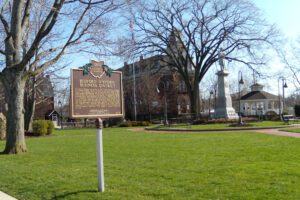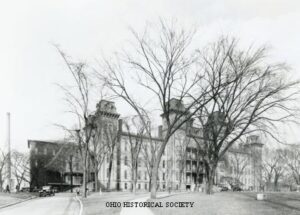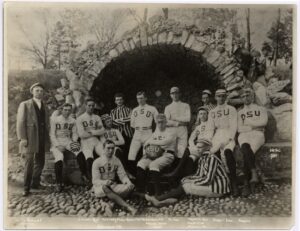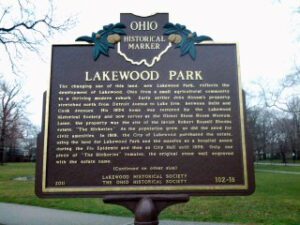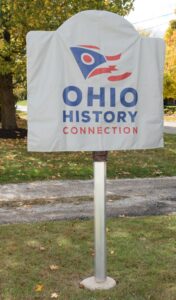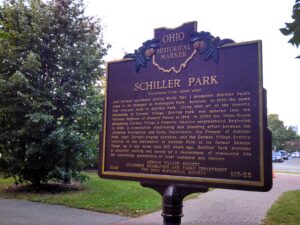, OH
One of five Civil War military posts in Columbus, Tod Barracks, named in honor of Governor David Tod, was built in 1863 as the headquarters for military administration in central Ohio. Necessitated by Lincoln’s call for 300,000 new troops, the post was constructed in two months with United States Engineer, Captain John Tod, as supervisor. Carpenters of the 88th Ohio Volunteer Infantry from Camp Chase, three miles west, built it. Tod Barracks served as a recruiting depot, a rendezvous point for new recruits, and place where soldiers mustered-out after the war. Located adjacent to Columbus’ Union Station, the post also served as a transfer point for soldiers and officers traveling through Ohio. (continued on other side)
, OH
The town of Bedford was settled in 1837. Early residents, Hezekiah and Clarissa Dunham donated the land that serves as Bedford Public Square. The Dunhams built one of the area’s first homes in 1832, which stands at 729 Broadway with the letters H & D above the doorway. Early settlers were attracted to the area by the abundance of natural resources and a large waterfall for mill sites. Bedford also served as a stagecoach stop on the route from Cleveland to Pittsburgh. The road or Turnpike Road as it was called was originally part of the Mahoning Indian Trail. By 1895 the road was renamed Main Street (and later Broadway) when the Akron, Bedford, and Cleveland Railway Company (ABC) traversed the middle of the street carrying passengers. The interurban is called “America’s first high speed long distance electric interurban” with speeds in excess of 60 miles per hour. [continued on other side]
, OH
For seven glorious summers, from July 13, 1895 to July 27, 1902, laughter and gaiety rang forth from the first amusement park in Franklin County. With intoxicants banned, the Park was enjoyed by the “respectable” folk of the Gay ’90s – the stone water tower/jail was quick to house any ruffian who threatened disharmony. Delighting young and old were the Zoological Garden, Ornithological Museum, the Scenic Railway roller coaster, Shoot the Chutes (the water slide of its day), swimming, boating, baseball, bowling, concerts, dancing, picnics, strolls in the cool woodlands, pony rides, fireworks, the orchestrion replicating a 36-piece orchestra, grande vaudeville, and theater. Minerva Park’s popularity faded with the opening of Olentangy Park, only 3 miles from downtown Columbus.
, OH
The Ohio School for the Deaf was established in 1829 by an act of the Ohio Legislature. Although the fifth school for the deaf in the country, it was the first school to be 100% funded by the state. The school first opened in a small rented building on the corner of Broad and High Streets. In 1834, construction of a permanent school was completed at the East Town Street location, now site of the Topiary Garden in Old Deaf School Park. It was there in 1869 that Ohio Governor Rutherford B. Hayes presided over the first commencement exercises in the nation for deaf students. By 1940, the school was overcrowded and the buildings were outmoded, leading to the purchase of 130 acres on Morse Road. The school at its current location opened on November 8, 1953.
, OH
In the fall, life for many in Columbus revolves around Ohio State University football, from the first kickoff in September to the last play in November. O.S.U.’s first home game took place at 2:30 P.M. on November 1, 1890. The Ohio State University played the University of Wooster on this site, which was then called Recreation Park. Just east of historic German Village, the park occupied the north side of Schiller (now Whittier) between Ebner and Jaeger in what is now Schumacher Place. The weather was perfect, and the crowd reportedly included a number of women, who cheered loudly. Nonetheless, O.S.U. lost to Wooster 64-0. Wooster, physically fit for the game, showed O.S.U. that training is critical to winning. The tradition of training continues. Today, on football Saturdays in Ohio Stadium on Woody Hayes Drive, the sound of an O.S.U. home game can be heard around the world.
, OH
The changing use of this land, now Lakewood Park, reflects the development of Lakewood, Ohio from a small agricultural community to a thriving modern suburb. Early settler John Honam’s property stretched north from Detroit Avenue to Lake Erie, between Belle and Cook Avenues. His 1834 home was restored by the Lakewood Historical Society and now serves as the Oldest Stone House Museum. Later, the property was the site of the lavish Robert Russell Rhodes estate, “The Hickories.” As the population grew, so did the need for civic amenities. In 1919, the City of Lakewood purchased the estate, using the land for Lakewood Park and the mansion as a hospital annex during the Flu Epidemic and then as City Hall until 1959. Only one piece of “The Hickories” remains; the original stone wall engraved with the estate name.
, OH
United Colored American Cemetery is among the earliest in situ African American cemeteries in Hamilton County. The 11.6 acres in Madisonville were purchased by the United Colored American Association (UCAA) after the legislated closure of their earlier Avondale cemetery. Many Avondale burials and headstones were moved prior to the new cemetery’s dedication on May 30, 1883. Designed by Adolph Strauch, United Colored American Cemetery features the looping roads and picturesque elements typical of his designs at Spring Grove and Eden Park. After the dissolution of the UCAA, Cincinnati mayor Charles P. Taft asked Union Baptist Church to take ownership and maintenance of the cemetery. Union Baptist assumed ownership in 1968 and burials continued until 2019. United Colored American Cemetery was listed on the National Register of Historic Places in 2022.
, OH
Long a gathering place for residents of Columbus, this area, which became known as Schiller Park, hosted German songfests, Fourth of July festivities, the 1864 and 1865 Ohio State Fairs, and the 1871 peace celebration commemorating the end of the Franco-Prussian War. In 1867, the City of Columbus purchased 23 acres of this area, then known as Stewart’s Grove, for $15,000 and named it City Park. On July 4, 1891, before a crowd of 50,000, the German-American community dedicated the 25-foot tall, 2,640 pound statue of German poet Friedrich von Schiller that had been cast in Munich, Germany and given as a gift to the City of Columbus. In 1905, the Park’s name was changed to Schiller Park. (Continued on other side)



